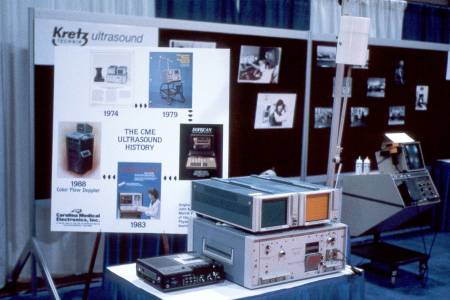 ***
*** 
The Dopscan CW Doppler Carotid
Imaging System
Pictured below and to the left is the ultrasound
scan unit that launched my ultrasound career and pictured to the right
is Dr.
John M. "Jack" Reid (and his wife) who designed it while working with
clinician Merrill Spencer
in Seattle, Washington in the mid 1970's. The fact that Dr. and Mrs.
Reid are drinking from Mason jars is a giveaway that the photo must have
been taken at the AIUM convention in Winston-Salem, N.C. in 1975 since
this was one of the many personal touches provided by Dr.
William McKinney as president of AIUM and host for that year's meeting!
The equipment photo is from a history of ultrasound display at a later
AIUM convention, probably in the late 1980's.
 ***
*** 
 ***
*** 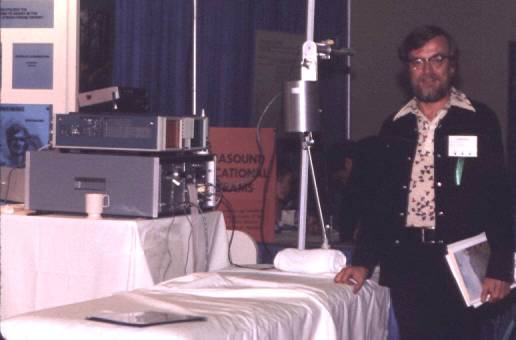
Above left, Dr.
Merrill Spencer and above right, Dr.
Jack Reid at the AIUM convention in
Winston-Salem, N.C. about
1975
The images below were made at the Bowman
Gray School of Medicine in 1974-1975. The scan unit employed a directional
CW Doppler module with the transducer suspended in a position-sensing mount.
The transducer was moved back and forth along the course of the carotid
artery and bifurcation. Whenever flow was detected a line would be
drawn in the proper X-Y location on a storage oscilloscope. After
scanning over the entire extracranial carotid area the instrument would
have a "map" of the course of the common, internal and external carotid
vessels. More careful interrogation could then be directed over any
areas of concern and Doppler waveform tracings could be obtained on an
oscilloscope or strip chart recorder so that both direction and amplitude
of flow could be assessed. The transducer could also be removed from
its direction-sensing arm and used for determination of flow direction
in the ophthalmic artery as shown in the fourth image below (by placing
the transducer over a thin layer of scan gel on the closed eyelid).
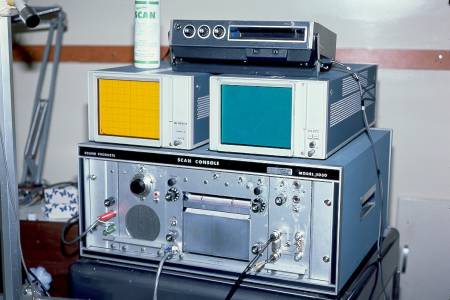 ***
*** 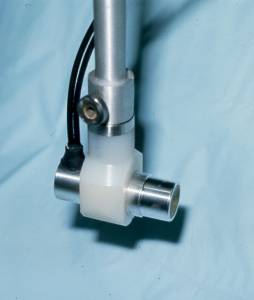
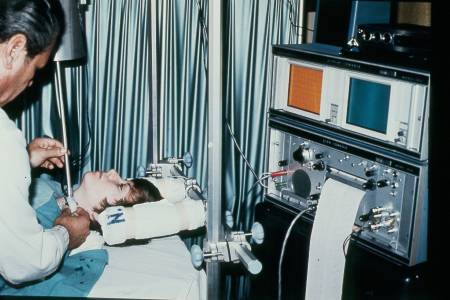 ***
*** 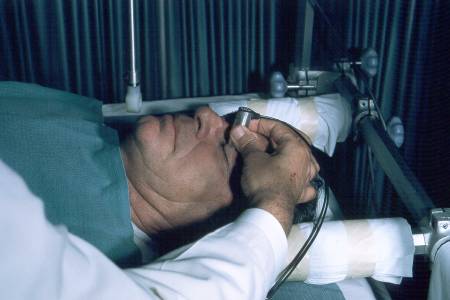
The image below shows a carotid angiogram (a) showing complete occlusion of the internal carotid branch. The corresponding DopScan image (b) also shows absence of expected flow signals where the internal carotid branch would normally be displayed (arrows). The Doppler waveform tracing from the ipsilateral ophthalmic artery (c) shows flow reversal.
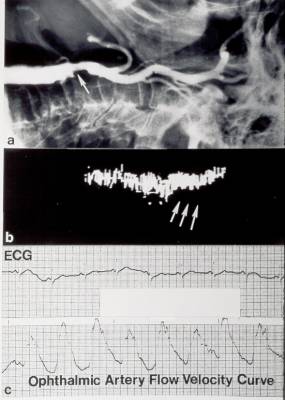
Reference: Blackwell
E, Merory J, Toole
JF, McKinney
W: Doppler ultrasound scanning of the carotid bifurcation.
Arch Neurol 1977 Mar;34(3):145-8.
Photos by Eric Blackwell,
M.D. made about 1974-75 at the Bowman Gray School of Medicine Ultrasound
Laboratory in Winston-Salem, N.C.
Page Last Updated 04/26/2002